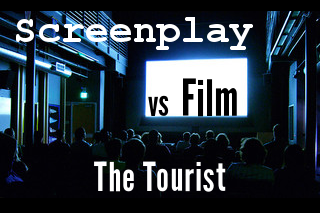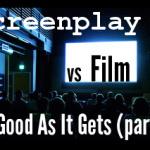While not a box office bomb, The Tourist didn’t set the box office on fire, especially considering the megawatt star power of its two leads, Johnny Depp and Angelina Jolie.
They don’t exactly have explosive chemistry, but their banter is quite witty and the lush backdrop of Venice is enjoyable. It’s a great movie to see if the closest you’ve come to Europe is a well-worn Lonely Planet travel guide.
One reason I think the movie fared poorly, at least in the United States, is because of the marketing. The trailers led you to believe that this was an action-packed thriller, occasionally interspersed with comic moments provided by Johnny Depp’s bumbling tourist.
But all the action in The Tourist was crammed into the trailer…and the misled audience would leave the theater with the impression that this movie was a poor man’s Bourne. But if you didn’t go in with high-octane expectations, then The Tourist is a lavish, languid, and certainly entertaining experience.
It certainly provides its own spin on the well-tread thriller genre, unraveling slowly, luxuriously…with a hefty dose of European flair tossed in. Its unique take is a welcome addition to the genre, one which holds special appeal for the feminine sensibility.
This is why the casting of Angelina Jolie as Elise Clifton-Ward is particularly problematic. The female populace, no matter how thin, how fashionable, is not particularly prone to sympathize with Jolie’s lonely British agent.
But if you can get over Angelina-envy, The Tourist is definitely worthwhile to watch–and not just for the Venetian scenery. When compared to its screenplay, it provides a wealth of screenwriting tips.
The screenplay I used for comparison was first written by Julian Fellows (creator of Downton Abbey and writer of Gosford Park, among other things), with revisions by William Wheeler and Jeffrey Nachmanoff…based on Jerome Salle’s Anthony Zimmer.
With all those cooks in the kitchen, the script is a bit of an odd duck. As a matter of fact, I liked the movie version much more than the screenplay, which is pretty unusual. There are two main reasons for that:
- divergent tones
- exposition overload
The screenplay hints at the luxurious production The Tourist eventually became, but still has too many gunfights and car chases which play out exactly as we’d expect.
Like the Janus charm Elise wears in the film, the screenplay I read seems to have two different stories with two different tones…and I had trouble embracing both.
The screenplay is also filled with very dry exposition, which fortunately they revamped in the movie. So this screenplay vs film edition is divided into two parts: tips on how to handle exposition and tips that fall into the miscellaneous screenwriting category.
Let’s start with the basic screenwriting tips:
Screenwriting Tip #1: Begin with a bang
In 12 Screenwriting Tips from Back to the Future, I mentioned how screenwriter Robert Zemeckis created an intriguing beginning to his movie without a single word of dialogue. That’s not the only way to create intrigue. You can also reel in your audience by providing only a limited amount of information, so they stick around to discover more.
In The Tourist screenplay, the movie begins with Elise (she’s named Cara Mason in the script) sitting in a cafe, being oogled by a waiter, and then receiving that all-important letter from Alexander, asking her to board the Orient Express, befriend a young man, and fool the people watching her into believing that young man is Alexander.
That’s a decent beginning, and sure, we’re wondering who exactly is this Alexander…but it would be even better if the screenplay’s beginning made us wonder who exactly is this Elise? And that’s exactly how the movie began. We first see Elise being tracked by an elite team of French Intelligence officers (they’re oogling her too of course), then we see her sit down at the cafe where she receives Alexander’s message.
It only adds a couple of minutes to the film, but it’s an important change because Elise is a key figure in the movie. She’s the one we’ll be watching for the next 90 minutes or so while Alexander is a shadowy figure who issues instructions but doesn’t reveal himself until the end. So it’s imperative that the audience is intrigued by her right away.
When you’re working on your screenplay, examine the beginning closely–does the writing on the first page compel whoever’s reading it to turn it? If it does, good for you. But that’s only part of it–now ask yourself, does my beginning also get the reader intrigued by or emotionally invested in my main character? If it doesn’t…you should think about rewriting it. As The Tourist shows, it may take only a few small changes to create that perfectly intriguing beginning.
Screenwriting Tip #2: Your characters can’t disappear from your screenplay
In the screenplay draft of The Tourist, there was a period when Elise’s character completely disappeared. There was no sight of her for almost 20 pages. You can’t have one of your lead characters disappear for one-fifth of a screenplay and expect to attract top talent for that role. If they have no lines, let alone screen time, what’s the appeal for them? (Now if they get a huge paycheck anyway…well, that’s another story). This was especially true for The Tourist which needed an A-list actress for the role of Elise because Elise’s character was beautiful, intelligent, lonely & captivating–and while a Victoria’s Secret model can pull off the first, it takes real skill to portray all four.
Fortunately, it’s easy to identify this script problem. I think the best way to do it is with index cards. Write down every story event of your movie onto index cards, using different colored cards for the main characters taking part in those scenes. (If more than one character is in a scene, you can cut the cards in half, or thirds, etc and then tape them together to form one card.) Arrange the cards into columns, and examine them closely. Is there a color that disappears and isn’t seen until 10 cards later? If you’re in the plotting stages, you can very easily solve the problem. But even if you’re in the middle of revising your fifth draft, don’t despair.
Here’s how The Tourist movie handled Elise’s vanishing act. First, they showed her on the Venetian streets, watching as Frank (in pajamas) runs on tiled roofs, pursued by two Russian goons. After integrating her in that scene, they got rid of a lot of unnecessary scenes where Frank befriends Domenico, an Italian policeman, and where he gets a CAT scan in the hospital (and just barely escapes the same Russian goons). Integration & elimination. Simple enough, right?
*The index card method I describe is just one way to identify a vanishing character. If you’ve developed another method, please share them in the comments!
Screenwriting Tip #3: Do the unexpected
The worst thing for your screenplay to be is predictable. For example, in the screenplay version of the Tourist, Frank befriends an Italian police inspector named Domenico. Domenico is charming, funny, and a thorough detective. He’s a good guy–who gets assassinated ten pages after we meet him. It’s done well…
INT. DOMENICO’S TERRACE FLAT – NIGHT
A saucepot simmers on the stove. The phone RINGS. Behind it is a WINDOW – pierced by one circular bullet hole.
The music still plays.
As our gaze drifts downwards we see Domenico’s bare feet, prone behind the kitchen island.
The phone RINGS and RINGS…
…but all the same, it’s a story beat we’ve seen a number of times and was entirely too predictable.
In the movie, Domenico is charming, funny, and a thorough detective. He also seems to be compassionate because he releases Frank from the Italian prison although Frank’s story seems preposterous…but then a reversal occurs. Domenico isn’t releasing Frank to freedom; he’s releasing him to the Russian goons in exchange for a bribe. A corrupt cop, that’s not entirely new. Sure, we’ve all seen that before. But the difference is that Domenico’s corruption was entirely unexpected (at least for me, maybe some of you spotted it a mile away), and it turned that little story sequence on its head.
I mentioned earlier that the movie eliminated a scene where Frank was getting a hospital examination and barely escapes the Russian goons. Well, Frank gains a little time by employing this little trick.
How many times have you seen that particular switcheroo? It’s a device that belongs in a Lifetime movie or a cop procedural, not in a multimillion dollar picture starring Johnny Depp & Angelina Jolie. In other words, it’s very much expected and way too predictable. I’m not sure how else Frank could have escaped from the hospital. In the movie, that thorny problem was solved by eliminating the hospital visit altogether–something to remember, if you’re looking to get rid of predictable moments in your current screenplay draft.
Final thoughts
I know there’s only 3 tips in this post. More screenwriting tips will be posted later this week. Comparing The Tourist screenplay & movie versions is also a great way to understand exposition, and I’ll be writing about that next week.
So often you hear that scripts get butchered by the studios when they go into production. Fortunately, that didn’t happen with the Tourist. Unlike the screenplay draft I read, the final product had a unified tone of romantic intrigue…perfect for a rainy day rental.
Watching a blank screen (with modifications) by Kenneth Lu




















